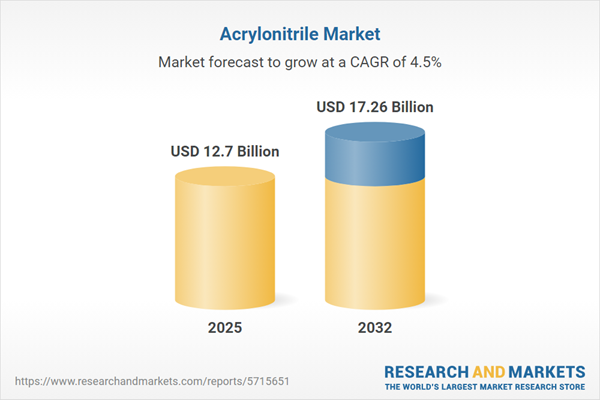Speak directly to the analyst to clarify any post sales queries you may have.
The acrylonitrile market is experiencing substantial transformation, demanding adaptive strategies from leaders navigating heightened operational challenges and evolving regulatory frameworks. Industry executives must leverage deep, sector-specific insights to respond effectively to rapid technology shifts and complex supply chain dynamics.
Acrylonitrile Market Snapshot: Size and Growth Outlook
The global acrylonitrile market is projected to grow from USD 12.16 billion in 2024 to USD 12.70 billion by 2025 and reach USD 17.26 billion by 2032, indicating a CAGR of 4.46%. Demand remains strong across industries such as automotive, construction, electronics, and healthcare, driven by the compound’s chemical resistance and performance versatility. This growth is shaped by technological improvements in polymer science and manufacturing, which are allowing broader application and improved operational efficiency. Strategic initiatives in production innovation and workforce development are enhancing market resilience and sustaining long-term sector progress.
Acrylonitrile Market Scope & Segmentation
- Application: Supports the creation of acrylic acid esters, acrylic fibers, acrylonitrile butadiene styrene (ABS), and nitrile rubber, forming a foundation for sectors such as textiles, consumer products, and industrial manufacturing where durability and performance are essential.
- Production Process: Predominant use of fixed bed and fluidized bed reactor technologies optimizes both productivity and compliance with operational standards and environmental guidelines, enabling manufacturers to respond to the industry's stricter requirements.
- End Use Industry: Key industries utilizing acrylonitrile include automotive for lightweight durable parts, construction for advanced materials, electronics for component reliability, and healthcare for safe, high-performing equipment. These connections highlight acrylonitrile's essential role across varied high-growth industries.
- Grade: The market offers both high purity and standard grades, ensuring solutions meet compliance benchmarks and different functional needs, from highly regulated applications to general industrial uses.
- Regional Coverage: Acrylonitrile is produced and consumed across the Americas, Europe, Middle East and Africa, and Asia-Pacific, with each geography presenting unique logistics and compliance demands. Adapting product distribution and regulatory strategies is essential for effective operations in these diverse regions.
- Notable Companies: Major participants such as China Petroleum & Chemical Corporation, Formosa Plastics Corporation, LG Chem Ltd., Saudi Basic Industries Corporation, LyondellBasell Industries N.V., Asahi Kasei Corporation, Mitsubishi Gas Chemical Company, Sumitomo Chemical Company, The Dow Chemical Company, and Shandong Dongyue Group reinforce their market positions through innovation and targeted collaborations.
Acrylonitrile Market: Key Takeaways for Strategic Decision-Makers
- Commitment to sustainability is accelerating investment in renewable feedstocks, pushing innovation to comply with evolving environmental standards.
- The adoption of advanced automation and data analytics across supply networks is enhancing operational efficiency, transparency, and risk management capabilities.
- Ongoing collaboration in electronics and advanced materials sectors is driving customized solutions and quick responses to shifting performance demands.
- Investment in partnerships, research, and workforce development is supporting resilience against regulatory and supply chain pressures.
- Optimizing logistics and deploying regional supply strategies are vital for reducing exposure to market fluctuations and maintaining reliable customer service.
Acrylonitrile Market Tariff Impact
New tariffs introduced in 2025 are increasing supply chain expenses in the acrylonitrile sector. Executive leadership is responding by advancing nearshoring, enhancing supplier diversification, and fast-tracking development of strategic partnerships to protect consistency and proactively address sourcing risks.
Methodology & Data Sources
This analysis is built on a foundation of executive interviews, a thorough technical literature review, and industry benchmarking. Scenario analysis and sensitivity assessments inform actionable direction for managing uncertainty and identifying growth avenues.
Why This Report Matters
- Provides actionable guidance on integrating advanced manufacturing technologies, fortifying supply chains, and elevating organizational competitiveness within the acrylonitrile landscape.
- Explains the practical implications of shifting regulations and supply chain strategies, supporting leaders in risk mitigation and thoughtful capital allocation.
- Equips decision-makers to pursue partnership prospects and prioritize strategies that address emerging change and innovation requirements.
Conclusion
By focusing on adaptability, ongoing development, and proactive collaboration, organizations can navigate regulatory shifts and maintain performance in the evolving acrylonitrile market.
Additional Product Information:
- Purchase of this report includes 1 year online access with quarterly updates.
- This report can be updated on request. Please contact our Customer Experience team using the Ask a Question widget on our website.
Table of Contents
3. Executive Summary
4. Market Overview
7. Cumulative Impact of Artificial Intelligence 2025
Companies Mentioned
The companies profiled in this Acrylonitrile market report include:- China Petroleum & Chemical Corporation
- Formosa Plastics Corporation
- LG Chem Ltd.
- Saudi Basic Industries Corporation
- LyondellBasell Industries N.V.
- Asahi Kasei Corporation
- Mitsubishi Gas Chemical Company, Inc.
- Sumitomo Chemical Company, Limited
- The Dow Chemical Company
- Shandong Dongyue Group Co., Ltd.
Table Information
| Report Attribute | Details |
|---|---|
| No. of Pages | 195 |
| Published | November 2025 |
| Forecast Period | 2025 - 2032 |
| Estimated Market Value ( USD | $ 12.7 Billion |
| Forecasted Market Value ( USD | $ 17.26 Billion |
| Compound Annual Growth Rate | 4.4% |
| Regions Covered | Global |
| No. of Companies Mentioned | 11 |









